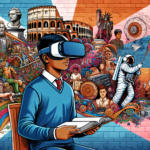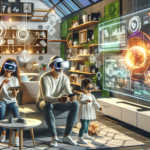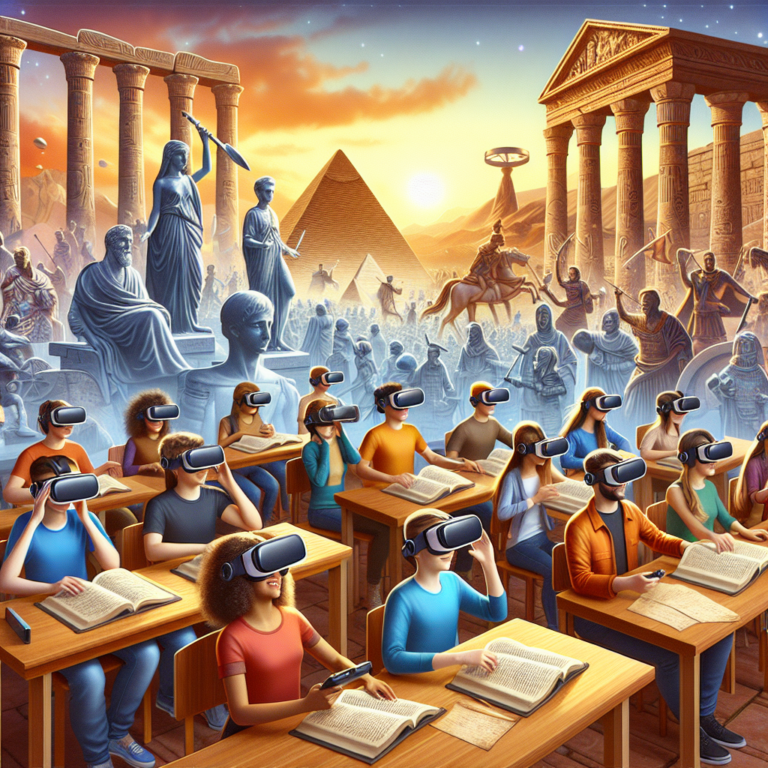Immerse Yourself in History: The Potential of Virtual Reality in Education 🌍
Revolutionizing Education Through Virtual Reality
Virtual Reality Education : Virtual reality (VR) has long been associated with gaming and entertainment, but what if it could transcend these boundaries and transport students back in time? Imagine stepping into a VR world where you can walk the streets of ancient Rome, witness the signing of the Declaration of Independence, or explore the pyramids of Egypt. The prospects of utilizing VR to simulate historical events for educational purposes promise to make learning not only effective but also incredibly engaging.
The Benefits of VR in Historical Education
Virtual Reality Education : Utilizing virtual reality in education presents a myriad of benefits that traditional teaching methods struggle to match. Let’s look at some key advantages:
- Enhanced Engagement: VR can capture students’ attention like nothing else. By immersing them in the historical context, learners are more likely to remember the information presented.
- Interactive Learning: Rather than passively consuming information, students can interact with their environment, ask questions, and create their own narrative experiences.
- Accessibility: Students from different backgrounds and learning abilities can access and engage with historical events on a level that suits them, making education more inclusive.
- Empathy Development: By literally stepping into someone else’s shoes, students can gain a greater understanding of the perspectives and experiences of people from the past.
How VR Can Bring Historical Events to Life
The ability of virtual reality to create lifelike simulations offers numerous possibilities to recreate pivotal moments in history. Here are a few examples:
Experience Historical Battles ⚔️
Imagine standing shoulder to shoulder with soldiers as they charge into the Battle of Gettysburg. VR can place students right in the action, helping them understand historical strategies, the chaos of war, and the human experiences behind these events. Students can analyze the decisions made by leaders, explore battlefield terrains, and even experience the emotions that soldiers felt during these crucial moments.
Walk Through Ancient Civilizations 🏛️
What if you could stroll through the busy markets of ancient Athens or traverse the majestic streets of Babylon? Virtual reality could facilitate this exploration, allowing students to not only observe but also interact with the people, architecture, and culture of ancient civilizations. By immersing themselves in these environments, learners can better appreciate the complexities of history and culture.
Witness Landmark Supreme Moments 📜
History is defined by significant events, and VR can provide a front-row seat to witness them. Whether it’s watching the signing of the Magna Carta or attending Martin Luther King Jr.’s iconic “I Have a Dream” speech, these experiences could deliver historical narratives that resonate deeply in a 3D context. Students will feel the weight of historical decisions and understand their ramifications in ways that textbooks often fall short.
Integrating VR Into the Curriculum
Successfully integrating VR into the classroom requires thoughtful planning and a willingness to innovate. Here are some essential steps:
1. Ensuring Access to Technology
While VR might sound appealing, schools must ensure that they have the necessary resources. This includes VR headsets, software, and access to high-speed internet. Schools might also look into partnerships with tech companies or grants to secure funding for VR installations.
2. Developing Curriculum That Incorporates VR
Teachers and educational leaders should collaborate with VR developers to create tailored historical experiences that align with educational standards and objectives. Content should be curriculum-driven, providing not just entertainment but educational value.
3. Training and Support for Educators
To leverage VR effectively, teachers need to be trained in how to use technology and integrate it into their teaching methodologies. Professional development workshops focusing on VR usage can empower educators to maximize its potential within their lessons.
4. Encouraging Student Feedback
Engaging students in the feedback process will ensure the VR experiences are relevant and impactful. Gathering insights from students can help refine the curriculum and improve future VR simulations.
The Future of Virtual Reality in Education
As technology advances, the future of VR in education looks bright. Here’s what we can expect:
- Increased Affordability: As VR headsets become more affordable, schools will find it easier to provide access to this technology.
- Enhanced User Experiences: The VR experience will continue to improve as software develops, providing a more immersive and realistic presentation of historical events.
- Collaboration with Historians: Educational institutions will likely collaborate with historians to ensure accuracy and depth in VR content, enriching the educational value of simulations.
- Global Learning Communities: VR can enable students from different parts of the world to connect and share their perspectives, creating a global classroom that transcends geographical boundaries.
Challenges and Considerations
While the benefits of VR in education are enticing, some challenges must be addressed:
1. Content Accuracy
Ensuring the accuracy of VR content is paramount. Collaborating with historians and experts is crucial to avoid misrepresentations of historical events.
2. Potential Distractions
Students need to remain focused; therefore, it’s essential to design VR experiences that keep them engaged without deviating from learning objectives.
3. Balancing Screen Time
As with any technology, educators must balance the benefits of VR with the potential downsides, such as excessive screen time.
The Call to Action for Educators and Policymakers
As we look towards the future, educators and policymakers must advocate for the integration of virtual reality into historical education. By collaborating with tech developers, investing in necessary resources, and providing training for teachers, we can usher in a new era of experiential learning that enriches our understanding of the past and prepares students for the future.
As we step into this promising future, one can only imagine how VR can reshape the landscape of education. Embrace the change, and let history come alive! 🎉




0 Comments